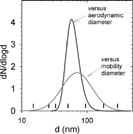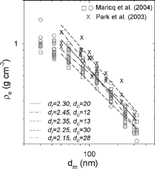The electrical low pressure impactor (ELPI) is a useful tool for recording transient particle size distributions, such as in motor vehicle emissions. But for sub-micron aerosols, the straightforward mass weighting and integration of these size distributions overestimates the particulate matter (PM) mass by a factor of two or more. The present article examines the sources of this discrepancy and develops an analysis that allows quantitative PM mass measurement with an accuracy of about 20%. This procedure is applied to measure motor vehicle PM emissions, and the results are compared with filter-based gravimetric determinations. Good agreement is achieved for diesel and direct injection gasoline vehicles. For particulate trap equipped diesel vehicles and conventional gasoline vehicles, the PM mass recorded by the ELPI is often substantially lower than the filter based mass owing to the gaseous adsorption artifact of the latter. Accurate work at very low emissions levels, less than ∼ 1 mg/mi, requires further study of how reliably the ELPI can provide semivolatile nanoparticle mass as well as an improved understanding of filter-based vehicle exhaust measurement.
INTRODUCTION
Heightened awareness of potential particulate matter (PM) health effects has led to the tightening of ambient air quality standards and to reductions in source PM emissions standards. In the case of motor vehicles this is imminent and dramatic. The United States Environmental Protection Agency Tier II and 2007 heavy-duty regulations reduce emissions levels by roughly an order of magnitude to 10 mg/mi and 10 mg/hp-hr, respectively. Europe's EURO 5 standard, slated for 2010, may limit light duty vehicle exhaust PM to as low as 5 mg/km.
These regulatory changes have in turn led to considerable interest in new aerosol instrumentation. This is driven by the desire for data with high spatial and temporal resolution that permits stringent tests of atmospheric models, source apportionment, higher quality epidemiological studies, and engine/aftertreatment development. PM mass data are of special interest because the regulations, ambient and motor vehicle, are mass based. The dilemma is that the regulatory method is stipulated to be gravimetric by collection onto filter media (CitationFederal Register, 2001), which is not conducive for high-throughput data collection on the grounds of both sensitivity and cost. The present paper examines how one recent instrument, the electrical low pressure impactor (ELPI) (CitationKeskinen et al. 1992; CitationMarjamäki et al. 2000), can be used for PM mass measurement. The paper emphasizes motor vehicle exhaust PM, but the results should find broader application to other PM mass measurement needs.
Interest in new aerosol instrumentation is evident in the recent review of diesel exhaust PM measurement by CitationBurtscher (2005). Devices to record PM mass include the tapered element oscillating microbalance (TEOM) (CitationPatashnick and Rupprecht 1991) and quartz crystal microbalance (QCM) (CitationBooker 2001), both of which register mass on a collection substrate by a change in resonant frequency. While they have the potential to automate PM mass measurement, comparisons to the gravimetric filter method have shown that water vapor, pressure fluctuations, loading, and other considerations can affect measurement quality (CitationXu et al. 2005; CitationPodsiadlik et al. 2003; CitationDickens et al. 2002). For time-resolved applications, these instruments are at a disadvantage because they record cumulative mass as opposed to an instantaneous concentration.
This is overcome by the photoacoustic soot sensor (CitationPetzold and Niessner 1996) and laser induced incandescence (CitationVander Wal and Weiland 1994), but at the price of a less direct mass determination. By recording the thermal energy absorbed from a light beam, either as an acoustic wave or incandescence, they are capable of high sensitivity and time resolution (CitationWitze et al. 2004), but solely to the black carbon component of exhaust PM. A more general capability for aerosol study is provided by the ELPI, which measures aerodynamic diameter, as well as the engine exhaust particle sizer (EEPS) and the differential mobility spectrometer (DMS500), which record electrical mobility diameter (both are similar to the electrical aerosol spectrometer (EAS; CitationTammet et al. 1998). These instruments record time-resolved particle size distributions and are therefore capable of indirectly providing PM mass. Thus far their mass measurement capability has not proven entirely satisfactory due both to instrumental limitations and to issues in data reduction. Below, these are discussed specifically with respect to the ELPI.
The issue of measuring PM at the impending 2007 regulatory levels is a difficult one presently of special interest from both the emissions and health effects points of view (CitationACES 2003). In this case PM mass is no longer dominated by soot. Instead, semivolatile hydrocarbons and sulfate contribute significantly and can dominate the mass. Relative to soot, these species are much more susceptible to interferences from sampling methods and artifacts. Even the ability of the gravimetric filter method to serve as a PM mass reference is in question (CitationChase et al. 2004). Here we first describe PM mass measurement with the ELPI in the case when soot (or other single mode) dominates the emissions, e.g., conventional diesel emissions. Then the analysis is extended to the case of a bimodal distribution. While preliminary results are encouraging, further work is needed to ascertain this capability.
ELPI Background
The ELPI combines aerodynamic size classification with the electrical detection of particles in the 0.01 to 10 μ m range. The papers by CitationKeskinen et al. (1992) and CitationMarjamäki et al. (2000) provide a detailed description of this instrument and its operation. The test aerosol first undergoes unipolar charging in a diode type corona discharge, and then passes through a Berner low-pressure cascade impactor to separate particles of different aerodynamic size. Electrometers record the current deposited on each impactor stage at a rate up to 1 Hz. These provide raw data from the ELPI in the form of electrical current versus aerodynamic diameter versus time. This simple picture becomes more complex for the following reasons: (1) there are four configurations of the ELPI; (2) corrections are needed to account for diffusion and electrostatic particle losses in the charger and cascade impactor; and (3) an algorithm is required to convert the raw current distribution to the desired information, such as a number or mass distribution.
First, the ELPI can be operated with or without a filter stage (CitationMarjamäki et al. 2002), and it can employ greased foil or porous sintered metal collection plates (CitationMarjamäki and Keskinen 2004). In its standard configuration of greased foils and no filter stage, the ELPI has 13 impactor stages with D50 cut points normally at 29 nm, 58 nm, 102 nm, 165 nm, 254 nm, 391 nm, 635 nm, 990 nm, 1.60 μ m, 2.45 μ m, 3.96 μ m, 6.67 μ m, and 10.12 μ m for stages 1–13, respectively. It is difficult to design impactors for operation below 25 nm. Instead a filter can be added after the 29 nm cutpoint to capture particles below this size, down to a broad lower cutoff in the range of 5–10 nm. Removal of an upper stage, typically the 6.67 μ m stage, makes room for the filter stage.
Substitution of porous stages helps reduce particle bounce and increase the loading capacity of the collection plates. Changes in the air flow induced by the roughened surface of the sintered plates alter their collection efficiency and, therefore, require recalibration of the cut points. For the instrument used in this work, the D50 values for the sintered substrates become 26 nm, 33 nm, 51 nm, 95 nm, 180 nm, 295 nm, 560 nm, 890 nm, 1.52 μ m, 2.32 μ m, 3.75 μ m, 6.31 μ m, and 9.58 μ m, the shifts in cut point being greater at smaller particle size.
The net efficiency of the corona discharge, ϵ c , relates the measured current, I, to particle number concentration via N = I /ϵ c . In the standard configuration, a trap immediately follows the charger to remove residual molecular ions. Since this also increases the small particles losses within the charger, the trap voltage is set to 0 V when using the filter stage. Consequently there are two effective charging efficiency curves used to describe the combination of charge placed on the particles and their penetration through the charger. These are both of the power law form
TABLE 1 Effective charging efficiency
Second, as they traverse the cascade impactor, particles are removed by impaction, diffusion, image charge, and space charge. The first of these provides the desired aerodynamic size classification. The remaining three are interfering loss mechanisms that hamper accurate size distribution measurements. Fortunately these losses are generally small and can be corrected for, as described by CitationVirtanen et al. (2001) and CitationMarjmäki et al. (2005), and discussed further in the following section. These corrections are implemented in the ELPI software, but they require information on the particle density, usually assumed to equal unity.
The third step is to convert the measured currents into a particle size distribution. The standard method applies the empirical charging efficiency defined in Equation (Equation1) to calculate a number weighted size histogram. But this brings up the intrinsic quandary that the ELPI charging efficiency depends on particle mobility diameter, whereas the ELPI measures aerodynamic diameter. This quandry is usually evaded by assuming that the particles are unit density spheres, for which mobility diameter equals aerodynamic diameter. Subsequent mass weighting and integration over particle size in principle yields PM mass. Although this procedure appears straightforward, it entails a number of implicit assumptions regarding particle diameter, charging, density, and response of the impactor that can lead to rather large errors in the calculated mass. These topics will be discussed in subsequent sections of this article to provide suggestions for understanding the interpretation of ELPI data and procedures that minimize these issues.
EXPERIMENTAL METHODS
Motor vehicle PM emissions are measured in the laboratory using a 122 cm single roll chassis dynamometer. Test vehicles are run over regulatory drive cycles, either the United States Federal Test Procedure (FTP) or the New European Drive Cycle (NEDC). The FTP consists of three phases, a cold start, a city portion, and a hot start that follows a ten-minute period during which the engine is turned off. The NEDC cycle has two phases, an urban (UDC) portion and an extra-urban (EUDC) phase representative of highway driving. PM emissions during each phase are reported here as mg/km.
A short, ∼ 1 m, corrugated metal hose connects the tailpipe to a remote mix tee where the exhaust is diluted at constant volume to a total flow of 9.9–17 m3/min prior to entering a 30.4 cm diameter stainless steel dilution tunnel. This arrangement reduces the delay time between the exhaust exiting the tailpipe and its dilution. And it diminishes the potential for heat-based storage—release artifacts prone during transport to the dilution tunnel in the conventional approach (Maricq et al. 1999).
Diluted exhaust is sampled at a minimum of 10 tunnel diameters downstream to ensure complete mixing of the exhaust and diluent. Gravimetric PM mass determinations are made primarily with Teflo filter media (47 mm diameter expanded PTFE Teflon with 2 micron effective pore size from Gelman Sciences), and some TX40 filters, at a sample rate of 0.057 m3/min. The filter face temperature was not controlled, but it remained in the range of 30–35°C as the vehicle exhaust temperature varied over the drive cycle. The filters are weighed in an EPA 2007 compliant temperature, humidity, and static controlled room using a 0.1 μ g balance. Additional filter-based mass measurements are performed using quartz filters and carbon analysis by the Horiba 1370 PM. In a sequence of thermal steps this instrument measures sulfate by conversion to SO2, semivolatile organic carbon by desorption in N2 followed by oxidation to CO2, and solid carbon by oxidation of the remaining material in O2. As reported by CitationAkard et al. (2004), the total carbon correlates very well with gravimetric measurement. Samples for ELPI analysis undergo secondary dilution by a factor of 8.8 or 71 using a series of one or two ejector pumps to extract and further dilute a sample from the tunnel.
Simutaneous PM emissions are recorded by ELPI and filter collection from five light-duty vehicles: a current model direct injection diesel vehicle with an oxidation catalyst, a diesel vehicle equipped with a diesel particulate filter (DPF) and an oxidation catalyst, a gasoline direct injection (GDI) vehicle, and two conventional port fuel injection (PFI) gasoline vehicles with three-way catalysts. The conventional diesel and PFI gasoline vehicles are representative of presently available vehicles, whereas the DPF equipped diesel and the GDI vehicles are prototypes, with emissions not necessarily representative of the technology. GDI vehicles can be operated in either a homogeneous mode, with early fuel injection and PM emissions similar to PFI gasoline vehicles, or a stratified mode, with late fuel injection and typically higher PM emissions. The stratified mode was used in this work. Overall, the PM emission rates of these vehicles span the range from ∼ 35 mg/km down to < 1 mg/km.
Pitfalls Interpreting ELPI Data
illustrates a number of the issues that arise when calculating the mass-weighted particle size distribution according to the standard ELPI data reduction. The data are from the tailpipe PM emissions of a diesel passenger car run over the NEDC drive cycle, where the two curves correspond to the urban and extra urban portions of the cycle. The same issues occur for diesel vehicles and other drive cycles. The numbers in refer to specific topics in the data analysis discussed immediately below.
FIG. 1 Mass-weighted particle size distributions as calculated by the standard ELPI data reduction. The data, plotted as smoothed curves instead of histograms, are from a current model light duty diesel vehicle run over the New European Driving Cycle (NEDC) drive cycle. The numbers label specific points of discussion in the text.
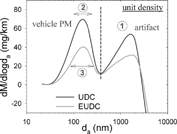
At first glance the mass distributions in may appear quite expected. They are bimodal, with a lower peak at 150 nm that corresponds nicely to a soot accumulation mode, and an upper peak at 1.5 μ m attributable to coarse mode particles, as depicted in generic motor vehicle PM size distributions, for example CitationKittelson et al. (1998). However, closer inspection reveals a number of problems with this interpretation.
#1—Coarse Mode Artifact
The upper mode of the apparently bimodal distribution in is not real. In contrast to the soot mode, the coarse mode is not reproducible from test to test. The total mass in the two modes corresponds to 68 mg/km for the urban and 42 mg/km for the extra urban portion of the drive cycle, three times the respective gravimetric values of 21 mg/km and 14 mg/km (recorded with Teflo filters). But this ignores the negative mass values registered above 3 μ m. Extending the calculation to the entire 0.01 to 10 μ m ELPI range gives 13 and –2 mg/km, also clearly unrealistic.
The apparent coarse mode arises as an artifact of non-idealities in the measured currents—electrical noise, electrometer drift, and small errors in the diffusion and electrostatic loss corrections—that are amplified by mass weighting. The charging efficiency given by Equation (Equation1) implies that mass scales with diameter as ∼ d 1.7, which exaggerates electrometer drifts, noise, etc. on the upper stages, for example, by a factor of ∼ 800 at 5 μ m relative to 100 nm. As discussed by CitationMarjamäki et al. (2005) and CitationLemmetty et al. (2005), this is an intrinsic problem that stems from the duality in the ELPI 3rd moment response functions. That is, in the presence of submicron particles it becomes difficult to tell whether a coarse mode is truly present, or not. Note that truncation of the currents, or derived concentrations, to eliminate negative values can significantly exacerbate the artifact. These negative currents are necessary to cancel the positive currents induced on the upper stages by small particles that pass through the stage without impacting (CitationMaricq et al. 2000).
# 2—Loading-Induced Size Shifts
CitationVan Gulijk et al. (2001) first noticed drifts in the ELPI currents over time during extended steady state engine emissions tests that lead to shifts in the size distribution. Subsequent application of the ELPI to analyzing mobility size selected particles found that even short collection times (∼ 20 min) at relatively low soot concentrations (5% of full scale) have a pronounced effect on the aerodynamic diameter measured by the ELPI (CitationMaricq and Xu 2004). These shifts occur when using greased aluminum foils (or other smooth) collection plates, but they are effectively overcome with the porous sintered metal substrates.
The shifts occur both with increasing collection time, and with decreasing dilution ratio. illustrates the latter case for secondary dilution levels of 8.8× and 71× sampling GDI vehicle exhaust from the dilution tunnel. The average ELPI current over each NEDC phase corresponds to about 1% of the ELPI maximum at 8.8× dilution, and about 0.1% for 71× dilution. The UDC lasts 780 s, whereas the EUDC takes 400 s. With sintered metal collection stages, the mass weighted PM distributions are independent of secondary dilution ratio. But with the greased foils the distribution shifts from a mean diameter of 76 nm at 71× dilution to 97 nm at the lower dilution level. While the shift may appear minor, it translates to a factor of 2 overestimation in the calculated PM mass.
FIG. 2 Comparison of mass weighted size distributions recorded with greased aluminum foil versus sintered metal substrates at levels of 8.8× and 71× secondary dilution. The PM data, plotted as smoothed curves, are from the exhaust of a GDI vehicle sampled at constant volume into a dilution tunnel operating at a flow rate of 17 m3/min.
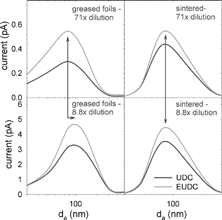
The shifts occur because of soot piles that accumulate under the impactor jets (CitationVan Guljik et al. 2001). These piles affect collection efficiency both by altering the flow streams past the collection plate and, perhaps more importantly, by filtering the portion of the sample flow that penetrates the piles. Consequently, particles that should penetrate to lower stages are instead erroneously collected on stages meant for larger particles. The sensitivity of these shifts to even small loadings could be specific to soot and related particles. Greased foil loading may have different consequences for other aerosols; for example, piles of salt crystals might exacerbate particle bounce and shift the size distribution to smaller diameter. But, as a result of the data in , we recommend that the sintered stages be used for motor vehicle PM measurements.
# 3—Widths of the Aerodynamic Distributions
Particles passing through the cascade impactor do not always land on the collection plate associated with their aerodynamic diameter, as shown in . Here raw ELPI currents are displayed that result from mobility selected poly alpha olefin (PAO) oil aerosols with d m = 50 and 200 nm. Based on a bulk density of 0.82 g/cm3, the corresponding aerodynamic diameters, d a , can be derived from
FIG. 3 ELPI analysis of mobility-selected poly alpha olefin oil particles comparing the response of greased foil and sintered collection plates. The data are corrected for multiply charged particles transmitted by the differential mobility analyzer. Lines represent raw ELPI currents; points illustrate fits to the impactor efficiency curves.
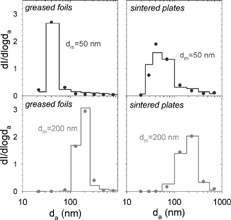
With greased foils, the d a = 42 nm particles overwhelmingly collect on the 29 nm stage, which has a logarithmic midpoint of 40 nm, and the d a = 175 nm particles are split between the 102 nm and 165 nm stages, with corresponding midpoints of 130 nm and 205 nm. In each case there is a tail, more pronounced at d a = 42 nm, that extends to larger diameter. This tail primarily arises from deposition by diffusion and image charge (also space charge for highly concentrated aerosols) and can be largely eliminated by the corrections described in the following section.
Even after correction, the ELPI distributions remain wider than the mobility-selected aerosols. This is particularly apparent in for the sintered stages. The widths arise from the finite slopes in the collection efficiency functions, which are significantly shallower for the sintered substrates as opposed to the greased foils. As a result, some particles are essentially mis-classified. This impacts the mass determination in three ways: the conversion of current to concentration (via the charging efficiency in Eqution 1), the particle's volume, and its effective density, if this is size dependent as in the case of soot. In general, the broadening biases the calculated PM mass high because of the cubic dependence on particle diameter. For example, the standard data reduction for the d a = 42 nm PAO oil droplet example recorded using sintered stages overestimates the particle mass by a factor of two. The discrepancy would be larger except that the error in charging efficiency for the mis-classified particles partially compensates for the error in the associated mass.
# 4—Role of Particle Density
Conversion of ELPI currents into concentration data requires knowing the particle mobility diameter, whereas the ELPI provides aerodynamic diameter. In the absence of separate mobility data, knowledge of the particle's effective density can be used to convert from mobility to aerodynamic size via Equation (Equation2). Soot particles form as agglomerates of approximately spherical 10–30 nm diameter carbonaceous primary particles. Because of their dendritic structure the mass of these agglomerates does not scale as the cube of the diameter, as it does for spherical particles. Instead these particles exhibit a fractal-like geometry in which mass scales as diameter to the d f power, where d f represents the fractal dimension. Recent work shows that the soot particle effective density, the mass per unit mobility volume, is given by
The decreasing effective density with particle growth narrows the aerodynamic size distribution relative to the mobility distribution. illustrates this point. The mobility-based size distribution is lognormal with a geometric standard deviation of σ g = 1.7–1.8, as found by CitationHarris and Maricq (2001) for diesel soot over a wide range of engines, fuels, and operating conditions. Recast in terms of aerodynamic diameter, the size distribution retains an approximately lognormal shape, but the width shrinks to σ g = 1.24, the equivalent of two impactor stages (shown by the vertical ticks). Consequently the impactor efficiency curves play a larger role in the widths of the ELPI distributions recorded for soot than for aerosols with constant particle density.
A Fitting Procedure to Calculate PM Mass
The preceding issues motivate the fitting procedure adopted here to derive a PM mass measurement from the ELPI. It can in principle be used with any of the ELPI configurations, but is applied here to the sintered substrate/filter stage configuration. The sintered stages greatly reduce loading dependent shifts in the impactor responses and the filter stage extends the sub-micron range of interest for motor vehicle PM emissions. We begin with the assumption that the PM is described by a lognormal distribution with a geometric standard deviation of σ g = 1.7, but that the mean diameter and particle concentration are unknown. This is based on earlier work (CitationHarris and Maricq 2001) that shows the lognormal shape to be an excellent description for a wide range of diesel soot, with correlation coefficients often > 0.99, and σ g to be nearly a universal constant. This assumption may break down for vehicles with a small soot mode, such as PFI gasoline and DPF equipped diesel vehicles, a situation that is addressed in the extension to bimodal distributions discussed in the following section.
This assumed distribution is fit to the measured ELPI currents treating the mean mobility diameter and number concentration as adjustable parameters. Starting with initial guesses for N 0 and μ g , the mobility distribution is discretized over log(d m ). At each size, d m,i , the current corresponding to N 0,i particles is calculated as I i = N 0,i ϵ c , with the efficiency given by Equation (Equation1). Next, the current sequentially deposited on each ELPI stage is calculated based on the particle's inertial impaction, diffusion, and image charge force.
Using the approach of CitationMarjamäki et al. (2003), Citation(2005), the net collection efficiency of the nth impactor stage is expressed as
FIG. 5 Calibration of the ELPI cascade impactor for greased Al foils and sintered collection plates using mobility size selected oil droplets. Measured d m are calculated from the ELPI currents by fitting them to the impactor efficiency curves, Equations. (4)–(6), to obtain d a , and converting the latter to mobility diameter via Equation (Equation2). Based on these results small refinements were made to the factory calibrated D50 cut points of the sintered stages.

TABLE 2 Impactor characteristics for sintered collection plates
Iteration of the above process yields values of N 0 and μ g for the mobility size distribution that best describes the ELPI currents. The corresponding PM mass is given in terms of the mobility volume and effective density by
The lognormal size distribution, N(d m ), and power law effective density permit an analytical integration to yield
This fitting procedure can be applied to the integrated currents recorded over a drive cycle, or it can be applied second by second to yield the transient PM mass emissions.
ELPI Versus Gravimetric PM Mass Measurements
Vehicle PM Emissions
The vehicle PM emissions tests divide into two categories: those meeting current PM emissions standards and those meeting the future low standard. We examine first the former group, which includes the conventional diesel and GDI vehicles. The diesel vehicle was run over the US FTP drive cycle, whereas the GDI vehicle was tested using the European NEDC cycle. ELPI data were collected in the sintered stages/filter stage configuration and at two levels of secondary dilution, 8.8× and 71×. Typical current distributions and the corresponding best fits (with R2 = 0.98) are illustrated in . These data exhibit a single peak, with no indication of a nucleation mode that sometimes accompanies motor vehicle PM emissions.
FIG. 6 Time integrated current distributions of PM sampled from light duty diesel vehicle exhaust. Histograms depict the raw currents in units of femtoamp seconds. Points represent the best fits to a lognormal mobility size distribution. The best fit mean mobility diameters for bags 1, 2, and 3 are μ g = 67, 61, and 71 nm, respectively, with 95% confidence intervals of ± 12%.
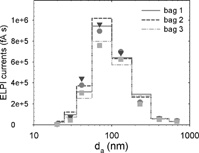
contrasts the PM mass derived via the standard ELPI data reduction to values determined by the above fitting procedure, and compares these to two different gravimetric measurements. The standard approach converts currents to number concentrations via the charger efficiency, weights each channel by the particle volume, scales this by unit density, and integrates the result over aerodynamic diameter. Only the lowest seven stages are included here to avoid the coarse mode artifact shown in . Clearly standard analysis grossly overestimates the mass emissions. In contrast, the fitting procedure gives close agreement with the gravimetric determinations, which themselves exhibit a small systematic difference owing to the adsorption of gaseous hydrocarbons (CitationChase et al. 2004). The bimodal fit, described below, allows for a possible nucleation mode of particles, which in these emissions is largely absent.
FIG. 7 Comparison of PM mass emissions from a light duty diesel vehicle obtained by the standard ELPI data reduction, the fitting procedure described in this paper, and filter collection using Teflo and TX40 filter media.
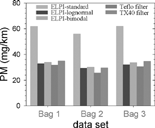
compares the ELPI fitting procedure to filter measurements (gravimetric and Horiba 1370PM) of PM emissions rates over ten separate diesel vehicle tests. The two methods agree quite well, yielding emission rates in the range of 18–36 mg/km. The ELPI-measured PM mass varies from 22% lower to 15% higher than its filter counterpart. It is 6% low on average. The GDI vehicle data in show similar agreement, with deviations between the ELPI and gravimetric methods that range from −1% to 20%. In part, lower readings from the ELPI can be attributed to the fact that filters adsorb gaseous hydrocarbons in addition to trapping particulate matter. The study by CitationChase et al. (2004) suggests that under the sampling conditions of our dilution system Teflo and quartz filters on average collect the equivalent of 0.5–1 mg/km and 0.8–1.4 mg/km gaseous material, respectively, roughly 2% of the gravimetric PM mass. As discussed in the following section, however, systematic differences can also arise from the analysis of the ELPI data, for example from uncertainties in the soot effective density and the geometric standard deviation of the soot mobility distribution.
FIG. 8 ELPI versus filter data for light duty diesel vehicle exhaust PM mass emissions. Unmarked filter data are gravimetric measurements using Teflo filters. Data marked with an * show the total carbon measured with quartz filters and analyzed by the Horiba 1370PM.
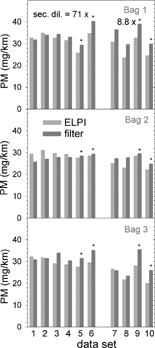
FIG. 9 ELPI versus gravimetric measurements of GDI vehicle exhaust PM mass emissions. Data are shown for the urban and extra-urban portions of the NEDC (first pair and second pair bars in tests 1–4) and for phases 1–3 of the FTP cycle (first, second, and third pair of bars 5–6).
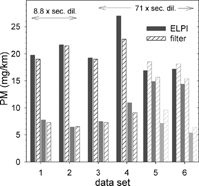
The situation is different for very low PM emitting vehicles, as illustrated in . Both the DPF equipped diesel vehicle and the PFI gasoline vehicles were tested over the FTP drive cycle. In panel A the PM mass calculated from the ELPI currents is less than half of the mass collected by the filters, except for the cold start phase, bag 1, of the gasoline vehicle test, where the two methods perhaps fortuitously agree. The higher emission levels recorded with the filters derive primarily from the gaseous adsorption artifact. This is corroborated by carbon analysis, which shows the collected PM to be > 90% organic, and by the fact that two filters in series record essentially the same mass gain (CitationChase et al. 2004). One should bear in mind, however, that the PM levels in represent roughly 10% of the 2007 standard, so that relative to the standard, the discrepancies are actually rather small.
FIG. 10 ELPI versus filter based measurements of DPF equipped diesel and PFI gasoline vehicle exhaust PM mass emissions. The three pairs of data for each vehicle/test correspond to bags 1, 2, and 3 of the FTP cycle. Teflo filters and gravimetric analysis was used for the gasoline vehicles, whereas quartz filters and carbon analysis by the Horiba 1370PM was used for the DPF equipped diesel vehicle. (a) DPF equipped diesel and gasoline vehicle 1. (b) Gasoline vehicle 2.
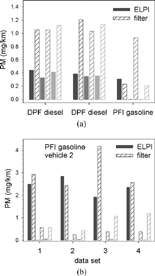
compares ELPI derived and gravimetric PM mass for four repeat tests of PFI gasoline vehicle 2. This development vehicle exhibits bag 1 PM emissions at about 50% of the 2007 level, whereas the bag 2 and 3 emissions remain comparable to those displayed in panel A. At 50% of the standard, the agreement between the ELPI and filter data remains good, with the exception of a possible outlier in the filter data. The PM mass was calculated from the ELPI in two ways: assuming the fractal soot density, and assuming a constant 0.8 g/cm3 density to allow for the possibility that the gasoline vehicle exhaust PM is dominated by organic material. This choice of density has on average a 20% effect on the calculated mass. In the case of bags 2 and 3, with emissions at 10% of the 2007 standard, it is not currently possible to state unequivocally which technique is the more accurate.
Error Analysis
According to Equation (Equation8) the PM mass calculated from the ELPI currents depends on five parameters, taking into account that ρ0 and d 0 are completely correlated. Two of these, N 0 and μ g , are provided by the ELPI. They derive from measurements of electrical charge and aerodynamic diameter, the accuracy of which is traceable to absolute standards. Size selected particles obtained with a differential mobility analyzer provide the calibration standard for diameter, which can be validated within about +/−1 nm using polystyrene latex spheres. The principal errors in the particle number concentration and mean diameter arise from noise and the goodness of fit to the assumed lognormal shape. The 95% confidence intervals are typically 17% and 12%, respectively, for N 0 and μ g , but these are negatively correlated as demonstrated below. Therefore, the fitting error translates into an approximately ± 7% uncertainty in calculated mass.
In principle one could include σ g as a third fitting parameter for the ELPI currents. But due to the narrow aerodynamic width, equivalent to two impactor stages, it is statistically too dependent on N 0 and μ g . Consequently, the best fit values for a three parameter model exhibit large standard errors. Fortunately, the mass calculation is insensitive to the choice of σ g . Using the two parameter model and varying σ g in the range of 1.6–1.8, leads only to a 3% variation in PM mass.
The remaining two parameters, the primary particle size and fractal dimension, characterize the soot particle effective density. These quantities are defined here with respect to mobility equivalent diameter; thus, they are close to, but not exactly, what one would record by transmission electron microscopy. In addition to its explicit contribution to PM mass, the effective density affects also the fits for N 0 and μ g . illustrates how the assumption of density affects particle number, size, and mass as calculated from the ELPI currents for the example of particles with an aerodynamic diameter of 50 nm. With increasing density the corresponding mobility diameter decreases. This decrease in turn implies that the number concentration calculated from the ELPI currents increases, since the charging efficiency of the corona charger decreases with decreasing mobility diameter. These trends are offsetting, and as a result the ELPI derived PM mass has a subdued dependence on density, for example changing by 28% for a factor of two increase or decrease in density from 1 g/cm3.
FIG. 11 The effect of particle density on the determination of number concentration, mobility diameter, and PM mass from ELPI currents.
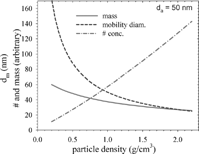
plots the effective density data reported by CitationPark et al. (2003) and CitationMaricq et al. (2004) for a variety of diesel and GDI vehicles. The best fit of the combined data to a fractal like density dependence (solid line) is given by d f = 2.3 and d 0 = 20 nm. The dashed and dash-dot lines illustrate other parameter combinations that bound the dataset. These four alternatives lead to a ± 15% variation relative to the PM mass determined from the best fit density. This depends weakly on μ g , climbing from 15% at μ g = 70 nm to 19% at μ g = 45 nm. Statistically combining this uncertainty with the 3% contribution from σ g and the 7% error from fitting the ELPI currents yields a net expected uncertainty of about 20% in the PM mass determination, a conclusion that is consistent with the experimentally recorded ELPI—filter comparisons in and .
Extension to Bimodal Distributions
In many circumstances the size distribution of vehicle exhaust particles is bimodal. There is an accumulation mode, typically in the region of 50–100 nm, that consists of soot coated to some degree by condensed hydrocarbons and sulfate, and a nucleation mode, almost always below 30 nm, formed from sulfate and semivolatile organic compounds as these exit the tailpipe and cool. It is possible in the case of DPF equipped diesel vehicles and gasoline vehicles that this mode can dominate. There are two ways to deal with the nucleation mode. One is simply to remove it with a thermodenuder or by hot dilution of the exhaust. The other is to extend the fitting procedure to include two size modes of particles.
We assume that the ELPI currents correspond to an underlying bimodal mobility distribution
Inserting the bimodal distribution and corresponding densities into Equation (Equation7) leads to the PM mass given by
Note that a primary particle diameter does not appear in the first term since the nuclei mode particles are assumed spherical, i.e., d f = 3. Evaluation of the mass requires fitting the ELPI currents to determine optimum values for the two mean diameters and two particle number concentrations. As described above, this is accomplished by discretizing the bimodal distribution and at each size calculating the currents on each stage from impaction, diffusion, and image charge forces. Unlike adding σ g as a third fitting parameter, adding N nuc and μ nuc does not lead to an overdetermined fit because the nucleation mode is almost always below 30 nm, whereas the soot mode typically lies above 50 nm.
demonstrates the fit for the case of a light duty diesel vehicle operated at 112 km/hr. In panel A, the bimodal nature of the PM emissions is not obvious in the ELPI currents, which only appear skewed to smaller size as compared to . However, the fitting procedure yields a bimodal distribution in panel B that is consistent with data taken using a scanning mobility particle sizer (SMPS). The mismatch in nucleation modes can be improved by choosing a larger value of σ nuc , to agree with the SMPS data, and a higher density based on the possibility that for this light duty vehicle sulfate may be an important constituent. These changes are mostly cosmetic, with relatively little impact on the calculated PM mass.
FIG. 13 Fitting of ELPI currents when the underlying size distribution is bimodal. (a) Raw ELPI currents and the best fit to two lognormal distributions. (b) Mobility distribution measured by SMPS and derived from the ELPI data.
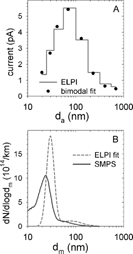
More important is the discrepancy between SMPS and ELPI fits for the accumulation mode. Here, the mass in the accumulation mode from the ELPI is similar to the PM measured at 80 km/hr, where there is no nucleation mode, whereas the SMPS derived mass is about a factor of two lower. On the other hand, the high ratio of nuclei to accumulation mode particles increases the demands on the accuracy of the diffusion loss correction and this could lead to an overestimate of the accumulation mode by the ELPI. Finally, the bimodal fit is robust in the sense that when a nucleation mode is absent the two additional parameters do not adversely affect the quality of the fit (assuming μ nuc is constrained to < 30 nm). Applied to the data in , the bimodal fit yields numbers of nuclei particles four times lower than the concentration of accumulation mode particles, but at ∼ 20 nm diameter; thus, their effect on PM mass is negligible, as shown by the lognormal/bimodal comparison in the figure. With respect to the PFI gasoline data in , the bimodal fit indicates a nucleation mode that represents approximately 10% of the PM mass, but the difference between bimodal and unimodal fits is not statistically significant.
DISCUSSION AND CONCLUSION
The largest contribution to the estimated 20% uncertainty in ELPI derived PM is a systematic one that comes from the uncertainty in the effective density. Thus, additional information to help refine the particle density in a specific application would help reduce the error bars for the ELPI measurement. In fact, this is the approach taken in the design of the Dekati Mass Monitor (DMM) (Dekati, Ltd.), an instrument very similar to the ELPI in that it, too, combines a cascade impactor and electrical detection of the particles (CitationKeskinen et al. 2004). The principal difference is that the DMM incorporates a mobility analysis region between the corona charger and cascade impactor that measures the mean mobility diameter of the test aerosol. Subsequently, the cascade impactor records the aerodynamic diameter, but this data must be corrected for particles removed in the mobility section. Comparison of the mobility and aerodynamic measurements provides an average effective density. This information is combined with the charger efficiency and the measured currents and size information to calculate PM mass on a second by second basis. Studies by CitationKittelson et al. (2004), CitationLehmann et al. (2004), and our own work indicate that the DMM records PM mass within about 20% of the gravimetric method at emissions levels where the filter artifact is small.
Recently two related real-time mobility based particle sizers have been introduced, the Engine Exhaust Particle Sizer (EEPS) (TSI, Inc.) and the DMS500 (Cambustion, Ltd.). In principle, PM mass can be calculated directly from size distributions produced by these instruments using Equation (Equation8) or Equation (Equation10). However, it remains to determine how sensitive this mass calculation is to uncertainties implicit in the data reduction for the EEPS and DMS500. It is unknown whether or not they, too, will benefit from a cancellation of errors with respect to uncertainties in the particle effective density, such as displayed in for the ELPI.
The ELPI has found extensive use in particle measurements ranging from ambient to fixed and mobile emissions. Ideally particles would pass through the cascade impactor until they reach the appropriate stage, allowing their mass to be calculated from the measured diameters and currents. While practical constraints hinder this direct approach, it is nevertheless possible to combine additional information regarding the particles, namely their known lognormal distribution, width, and effective density, with the ELPI data to provide quantitative PM mass measurement capability. This approach reduces the number of unknown parameters needed to describe a mass weighted soot distribution from five to two, namely the particle number concentration and geometric mean diameter. In turn, these can unambiguously be derived from the ELPI current distribution. As a result, it should be possible to adopt the ELPI for online real-time PM mass measurement. It appears that this capability extends down to the 2007 emission standard; however, at the lower end of that standard the question of how accurately the ELPI or the filter method can measure PM remains.
Acknowledgments
We thank Mike Loos and Adolfo Mauti for their help with the vehicle tests, Diane Podsiadlik and Gary Duszkiewicz for assistance with the filter-based PM mass measurements, and Joel Richert for help with the Horiba 1370PM data.
REFERENCES
- ACES . 2003 . Workshop on Strategies to Evaluate Diesel Emissions in the ACES Project, Denver , http://www.healtheffects.org/ACES/ACES-agenda.htm
- Akard , M. , Oestergaard , K. , Chase , R. E. , Richert , J. F. O. , Fukushima , H. and Adachi , M. 2004 . Comparison of An Alternative Particle Mass Measurement with Advanced Microbalance Analysis . SAE Technical paper No. 2004-01–0589 ,
- Booker , D. Development of a Real-Time Transient Cycle Mass Monitor . Proc. ETH Conference on Nanoparticle measurement . Aug. 2000 . Edited by: Mayer , A. paper 20
- Braun , A. , Huggins , F. E. Seifert , S. 2004 . Size-Range Analysis of Diesel Soot with Ultra-Small Angle X-Ray Scattering . Combust. Flame , 137 : 63 – 72 . [CROSSREF] [CSA]
- Burtscher , H. 2005 . Physical Characterization of Particulate Emissions from Diesel Engines: A Review . J. Aerosol Sci. , 36 : 896 – 932 . [CROSSREF] [CSA]
- Chase , R. E. , Duszkiewicz , G. J. , Richert , J. F. O. , Lewis , D. , Maricq , M. M. and Xu , N. 2004 . PM Measurement Artifact: Organic Vapor Deposition on Different Filter Media . SAE Technical paper No. 2004-01-0967 , [CSA]
- Dickens , C. J. , Payne , E. L. , Reading , A. H. and Feest , E. A. Particle Measurement Program (PMP, Final Report of Phase 1 of Module 3: Development of Candidate Systems–Light Duty Vehicles , AEAT/DDSE/R/ED15003-Final Report, www.dft.gov.uk/stellent/groups/dft_roads/documents/page/dft_roads_506900.pdf
- Federal Register . 2001 . Control of Air Pollution from New Motor Vehicles: Heavy-Duty , 66 ( 12 ) : 5172 [CSA]
- Harris , S. J. and Maricq , M. M. 2001 . Signature Size Distributions for Diesel and Gasoline Engine Exhaust Particulate Matter . J. Aerosol Sci. , 32 : 749 – 764 . [CROSSREF] [CSA]
- Hinds , W. C. 1999 . Aerosol Technology. , New York : Wiley .
- Keskinen , J. , Pietarinen , K. and Lehtimaki , M. 1992 . Electrical Low Pressure Impactor . J. Aerosol Sci. , 23 : 353 – 360 . [CROSSREF] [CSA]
- Keskinen , J. , Moisio , M. , Marjamäki , M. , Virtanen , A. and Ristimäki , J. 2004 . Method of Measuring Density Properties of a Particle Distribution . International Patent Application WO03021235. Also Finnish patent FI115075B (2001) , [CSA]
- Kittelson , D. B. 1998 . Engines and Nanoparticles: A Review . J. Aerosol Sci. , 29 : 575 – 588 . [CROSSREF] [CSA]
- Kittelson , D. , Hands , T. Nickolaus , C. 2004 . Mass Correlation of Engine Emissions with Spectral Instruments . JSAE Paper , 20045462[CSA]
- Lehmann , U. , Niemelä , V. and Mohr , M. 2004 . New Method for Time-Resolved Diesel Engine Exhaust Particle Mass Measurement . Environ. Sci. Technol. , 38 : 5704 – 5711 . [PUBMED] [INFOTRIEVE] [CROSSREF] [CSA]
- Lemmetty , M. , Marjamäki , M. and Keskinen , J. 2005 . The ELPI Response and Data Handling II: Properties of Kernels and Data Inversion . Aerosol Sci. Technol. , 39 : 583 – 595 . [CROSSREF] [CSA]
- Maricq , M. M. and Xu , N. 2004 . The Effective Density and Fractal Dimension of Soot Particles from Premixed Flames and Motor Vehicle Exhaust . J. Aerosol Sci. , 35 : 1251 – 1274 . [CROSSREF] [CSA]
- Maricq , M. M. , Podsiadlik , D. H. and Chase , R. E. 2000 . Size Distributions of Motor Vehicle Exhaust PM: A comparison Between ELPI and SMPS Measurements . Aerosol Sci. Technol. , 33 : 239 – 260 . [CROSSREF] [CSA]
- Maricq , M. M. , Chase , R. E. , Podsiadlik , D. H. and Vogt , R. 1998 . Vehicle Exhaust Particle Size Distributions: A Comparison of Tailpipe and Dilution Tunnel Measurements . SAE Technical paper No. 1999-01-1461 , [CSA]
- Marjamäki , M. , Lemmetty , M. and Keskinen , J. 2005 . ELPI Response and Data Reduction I: Response Functions . Aerosol Sci. Technol. , 39 : 575 – 582 . [CROSSREF] [CSA]
- Marjamäki , M. and Keskinen , J. 2004 . Effect of Impaction Plate Roughness and Porosity on Collection Efficiency . J. Aerosol Sci. , 35 : 301 – 308 . [CROSSREF] [CSA]
- Marjamäki , M. 2003 . Electrical Low Pressure Impactor: Modifications and Particle Collection Characteristics , Tampere University of Technology . Ph.D Thesis, Publication 449
- Marjamäki , M. , Ntziachristos , L. , Virtanen , A. , Ristimäki , J. , Keskinen , J. , Moisio , M. , Palonen , M. and Lappi , M. 2002 . Electrical Filter Stage for the ELPI . SAE Technical paper No. 2002-01-0055 , [CSA]
- Marjamäki , M. , Keskinen , J. , Chen , D.-R. and Pui , D. Y. H. 2000 . Performance Evaluation of the Electrical Low Pressure Impactor (ELPI) . J. Aerosol Sci. , 31 : 249 – 261 . [CROSSREF] [CSA]
- Park , K. , Cao , F. , Kittelson , D. B. and McMurry , P. H. 2003 . Relationship Between Particle Mass and Mobility for Diesel Exhaust Particles . Environ. Sci. Technol. , 37 : 577 – 583 . [PUBMED] [INFOTRIEVE] [CROSSREF] [CSA]
- Patashnick , H. and Rupprecht , E. G. 1991 . Continuous PM-10 Measurement Using the Tapered Element Oscillating Microbalance . J. Air and Waste Manage. Assoc. , 41 : 1079 – 1083 . [CSA]
- Petzold , A. and Niessner , R. 1996 . Photoacoustic Soot Sensor for In-Situ black Carbon Monitoring . Appl. Phys. B , 63 : 191 – 197 . [CROSSREF] [CSA]
- Podsiadlik , D. H. , Chase , R. E. , Lewis , D. and Spears , M. 2003 . Phase-Based TEOM Measurements Compared with Traditional Filters for Diesel PM . SAE Technical paper No. 2003-01-0783 , [CSA]
- Scheer , V. , Kirchner , U. , Casati , R. , Vogt , R. , Wehner , B. , Philippin , S. , Wiedensohler , A. , Hock , N. , Schneider , J. , Weimer , S. and Borrmann , S. 2005 . Composition of Semi-Volatile Particles from Diesel Exhaust . SAE Technical paper No. 2005-01-0197 , [CSA]
- Tammet , H. , Mirme , A. and Tamm , E. 1998 . Electrical Aerosol Spectrometer of Tartu University . J. Aerosol Sci. S1. , 29 : 427 – 428 . [CROSSREF] [CSA]
- Tobias , H. J. , Beving , D. E. , Ziemann , P. J. , Sakurai , H. , Zuk , M. , McMurry , P. H. , Zarling , D. , Waytulonis , R. and Kittelson , D. B. 2001 . Chemical Analysis of Diesel Engine Nanoparticles Using a Nano-dma/Thermal Desorption Particle Beam Mass Spectrometer . Environ. Sci. Technol. , 35 : 2233 – 2243 . [PUBMED] [INFOTRIEVE] [CROSSREF] [CSA]
- Vander Wal , R. L. and Weiland , K. J. 1994 . Laser Induced Incandescence: Development and Characterization Towards a Measurement of Soot Volume Fraction . Appl. Phys. B , 59 : 445 – 452 . [CROSSREF] [CSA]
- Van Gulijk , C. , Schouten , H. , Marijnissen , J. C. M. , Makkee , M. and Moulijn , J. A. 2001 . Restriction for the ELPI in Diesel Particulate Measurements . J. Aerosol Sci. , 32 : 1117 – 1130 . [CROSSREF] [CSA]
- Virtanen , A. , Marjamäki , M. , Ristimäki , J. and Keskinen , J. 2001 . Fine Particle Losses in Electrical Low-Pressure Impactor . J. Aerosol Sci. , 32 : 389 – 401 . [CROSSREF] [CSA]
- Witze , P. O. , Chase , R. E. , Maricq , M. M. , Podsiadlik , D. H. and Xu , N. 2004 . Time-Resolved Measurements of Exhaust PM for FTP-75: Comparison of LII, ELPI, and TEOM Techniques . SAE Technical paper No. 2004-01-0964 , [CSA]
- Xu , S. , Clark , N. N. , Gautam , M. and Wayne , W. S. 2005 . Comparison of Heavy-Duty Truck Diesel Particulate Matter Measurement: TEOM and Traditional Filter . SAE Technical paper No. 2005-01–2153 , [CSA]
